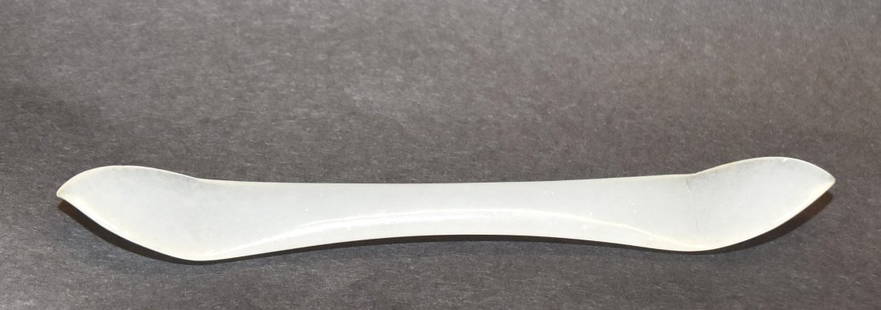
Egyptian Faience Ushabti + 2 Carved Bone Hair Pins
Similar Sale History
View More Items in Brooches & PinsRelated Brooches & Pins
More Items in Brooches & Pins
View MoreRecommended Jewelry
View More




Item Details
Description
Egypt, Late Dynastic Period, 26th to 31st Dynasty, ca. 664 to 332 BCE. Two beautifully hand carved Egyptian hair pins made of bovine bone and a delightful mold-formed faience ushabti, all decorated in hues of cream, buff, and sage green. With elongated forms and sharp ends, the two pins would have been used for securing long hair in an upswept style and are typically found in female tombs. The faience Ushabti stands in mummiform with fused legs and feet and also would have been found in a tomb, as ushabti were meant to be servants for the deceased. Intended to help with agricultural labor in the afterlife, the sculpture holds a pick and hoe in arms crossed atop the chest. Seen as indispensable in the afterlife for the recently deceased, these examples now enhance the aesthetic value of our present lives! Size of Largest: 3.6875" L x 0.25" W x 0.4375" H (9.4 cm x 0.6 cm x 1.1 cm)
Ushabti (or shabti) dolls are figures shaped like adult male or female mummies wearing traditional ancient Egyptian headdresses and were intended top help the recently deceased with agricultural labor in the afterlife. The ancient Egyptians believed that after they died, their spirits would have to work in the "Field of Reeds" owned by the god of the underworld, Osiris. This meant doing agricultural labor was required by all members of society, from workers to pharaohs.
Ancient hair pins were frequently used as weapons in history and literature according to many primary sources. For example: in "Roman History", Cassius Dio reports how Fulvia stabbed the tongue of Cicero's decapitated head with her hair pin and, in "The Golden Ass", Apuleius writes of a woman who stabs her husband's murderer in the eyes with her hairpins. Undoubtedly most notable, however, is Cleopatra's suicide, during which she is believed to have administered the asp's poison via cutting herself with her hairpin, "swiftly terminating three thousand years of pharaonic rule and changing the course of Western history." (Fletcher, J. 2016 The Egyptian Hair Pin: practical, sacred, fatal, Internet Archaeology 42.)
Provenance: ex Estate of Eldert Bontekoe, Pegasi Numismatics, Ann Arbor, Michigan USA acquired before 2000
All items legal to buy/sell under U.S. Statute covering cultural patrimony Code 2600, CHAPTER 14, and are guaranteed to be as described or your money back.
A Certificate of Authenticity will accompany all winning bids.
We ship worldwide to most countries and handle all shipping in-house for your convenience.
#158460
Ushabti (or shabti) dolls are figures shaped like adult male or female mummies wearing traditional ancient Egyptian headdresses and were intended top help the recently deceased with agricultural labor in the afterlife. The ancient Egyptians believed that after they died, their spirits would have to work in the "Field of Reeds" owned by the god of the underworld, Osiris. This meant doing agricultural labor was required by all members of society, from workers to pharaohs.
Ancient hair pins were frequently used as weapons in history and literature according to many primary sources. For example: in "Roman History", Cassius Dio reports how Fulvia stabbed the tongue of Cicero's decapitated head with her hair pin and, in "The Golden Ass", Apuleius writes of a woman who stabs her husband's murderer in the eyes with her hairpins. Undoubtedly most notable, however, is Cleopatra's suicide, during which she is believed to have administered the asp's poison via cutting herself with her hairpin, "swiftly terminating three thousand years of pharaonic rule and changing the course of Western history." (Fletcher, J. 2016 The Egyptian Hair Pin: practical, sacred, fatal, Internet Archaeology 42.)
Provenance: ex Estate of Eldert Bontekoe, Pegasi Numismatics, Ann Arbor, Michigan USA acquired before 2000
All items legal to buy/sell under U.S. Statute covering cultural patrimony Code 2600, CHAPTER 14, and are guaranteed to be as described or your money back.
A Certificate of Authenticity will accompany all winning bids.
We ship worldwide to most countries and handle all shipping in-house for your convenience.
#158460
Condition
Minor chips/nicks commensurate with age. Expected softening of detail and green marking on back on Ushabti. Lovely earthen deposits throughout. Overall, intact and excellent.
Buyer's Premium
- 24.5%
Egyptian Faience Ushabti + 2 Carved Bone Hair Pins
Estimate $600 - $900
2 bidders are watching this item.
Get approved to bid.
Shipping & Pickup Options
Item located in Louisville, CO, usSee Policy for Shipping
Payment

TOP



















































![Lock of Robert E. Lee's Hair & Archive: LARGE LOCK OF ROBERT E. LEE'S HAIR FROM HIS LEXINGTON, VIRGINIA DOCTOR, HOWARD T. BARTON. Large lock of General Robert E. Lee's hair, taken at death. [Lexington, Virginia], [1870]. Approx. length 6 in](https://p1.liveauctioneers.com/7226/325455/175169168_1_x.jpg?height=310&quality=70&version=1712370394)




























